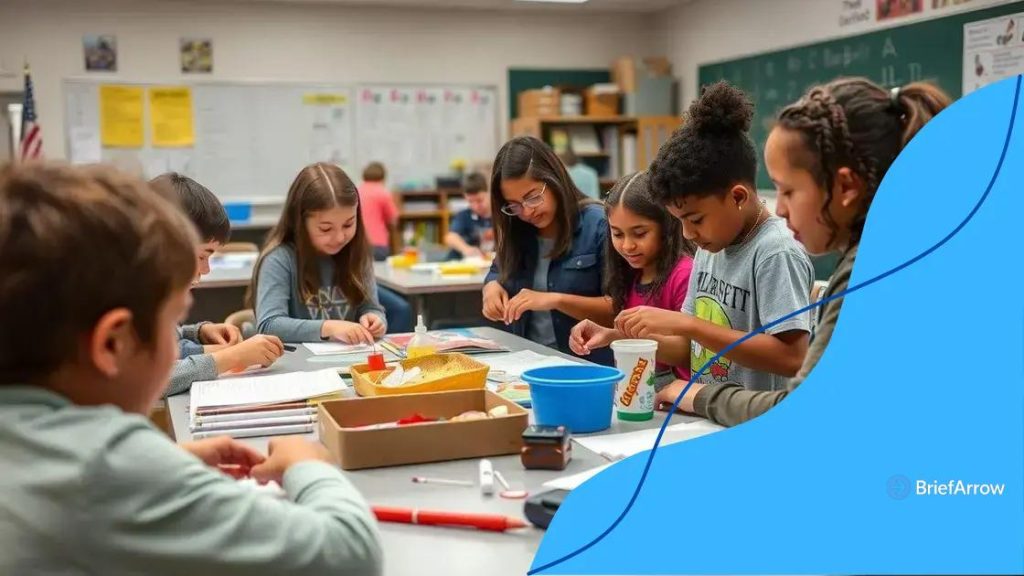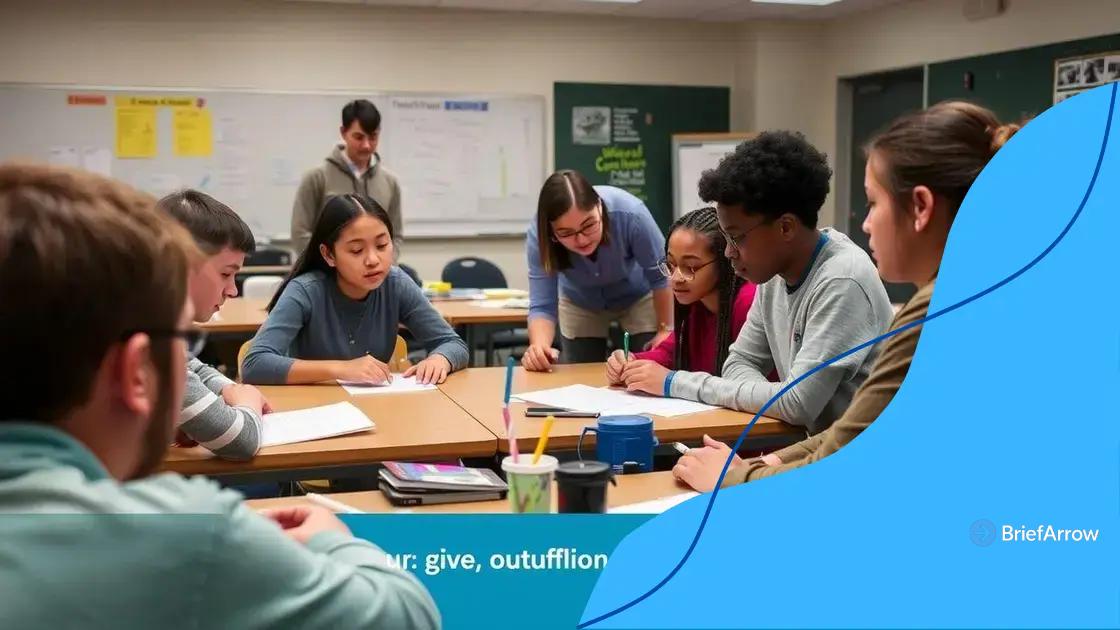Studies on project-based learning effectiveness: what you need to know

Anúncios
Project-based learning enhances student engagement and learning by allowing students to work on real-world projects, fostering critical thinking, collaboration, and essential life skills.
Studies on project-based learning effectiveness provide valuable insights into how this educational approach engages students. Have you wondered how these projects impact learning outcomes? Let’s explore what the research shows.
Anúncios
Understanding project-based learning
Understanding project-based learning is essential for educators looking to enhance student engagement. This approach emphasizes real-world problems and challenges, making learning more relevant.
Project-based learning involves students working on a project over an extended period. They explore complex issues, gain knowledge, and develop skills through hands-on experiences.
Key Elements of Project-Based Learning
This method typically includes several key components:
Anúncios
- Real-world relevance: Projects reflect real-life situations.
- Collaboration: Students work together, enhancing their teamwork skills.
- Critical thinking: Students analyze and solve complex problems.
- Reflection: Learners assess their progress and outcomes.
Project-based learning encourages students to take ownership of their learning. They engage more deeply since they are not just passive recipients of information.
Additionally, this approach fosters a sense of community in the classroom. Students share their ideas and work towards common goals, creating a supportive learning environment that promotes mutual respect.
Benefits for Students
Engaging in project-based learning also provides multiple benefits for students. Here are some of the most notable advantages:
- Enhanced retention of information through practical application.
- Improved problem-solving and critical thinking skills.
- Increased motivation and enthusiasm about learning.
When students see the connection between what they learn and the real world, they become more motivated. This method can lead to a greater appreciation of the subject matter.
Key benefits of project-based learning
Exploring the key benefits of project-based learning reveals why this approach is gaining popularity in education. This method empowers students and enhances their learning experience.
One main advantage is the development of critical thinking skills. As students tackle real-world problems, they learn to analyze situations, brainstorm solutions, and implement effective strategies.
Enhanced Engagement
Students are more engaged in their learning when involved in meaningful projects. They are not just passive learners but active participants in their education. This involvement fosters curiosity and a desire to learn.
- Projects create a hands-on learning environment.
- Students tend to retain information better through active participation.
- Interaction with peers encourages collaboration.
Another benefit is the improvement in teamwork and communication skills. When working in groups, students learn how to express ideas clearly and listen to others. This collaboration teaches them how to work effectively with diverse personalities.
Real-World Application
Through project-based learning, students see the real-world relevance of their education. They connect classroom knowledge with practical applications, making lessons more relevant.
- Students gain insights into various fields by solving real problems.
- Exposure to real-world challenges prepares them for future careers.
- This approach develops a sense of responsibility as they contribute to their community.
Lastly, project-based learning encourages self-directed learning. Students take charge of their projects, fostering independence and motivation. This ownership increases their investment in their own education.
Common challenges in project-based learning

Understanding the common challenges in project-based learning is crucial for educators. While this approach offers many benefits, it also comes with obstacles that can impact its effectiveness.
One significant challenge is managing the diverse needs of students. In a project-based learning environment, students have varying skill levels and learning styles. This diversity can make it difficult for educators to provide equal support. Striking a balance between guiding students and allowing them to explore independently is vital.
Time Management
Another common issue is time management. Projects often require a substantial amount of time and effort. Teachers may find it challenging to fit these projects into their existing curriculum while ensuring all learning objectives are met.
- Setting realistic timelines can help manage expectations.
- Breaking projects into smaller tasks may make them more manageable.
- Regular check-ins can keep students on track.
Additionally, assessment can pose a challenge in project-based learning. Traditional testing methods may not accurately reflect a student’s understanding and skills gained through practical projects. Educators need to develop new assessment strategies that capture students’ efforts and learning outcomes.
Resource Availability
Limited resources can also hinder project-based learning. Many projects require materials or technology that schools may not have readily available. This limitation can restrict the types of projects initiated and the creativity of students.
- Seeking community partnerships can provide additional resources.
- Utilizing low-cost materials encourages creativity.
- Integrating technology may require training or support.
Finally, resistance to change from traditional teaching methods can be a barrier. Both teachers and students may struggle to adjust to a more hands-on, collaborative approach. Providing training and support can help ease this transition.
Successful case studies
Successful case studies in project-based learning provide valuable insights into its effectiveness. These examples show how real-world projects can enhance student engagement and deepen understanding.
One notable case is a high school in California that implemented project-based learning to redesign their science curriculum. Students worked on a project that involved creating sustainable gardens. This project not only taught them about ecosystems but also made them aware of environmental issues in their community.
Collaboration with Local Experts
In this case study, students partnered with local gardeners and environmentalists. This collaboration allowed students to gain practical knowledge and experience. They learned essential skills while engaging with community members.
- Students learned through hands-on experience in real gardens.
- Guest speakers shared their expertise, adding value to the project.
- Students presented their findings at a community event, enhancing their public speaking skills.
Another example comes from an elementary school in New York that focused on history through a project on local landmarks. Students researched local historical sites and created presentations to showcase their findings. This approach ignited their interest in history.
Engagement and Critical Thinking
The students not only learned facts but also developed critical thinking skills as they analyzed historical significance. They engaged with the community by inviting parents to the presentations.
- Students researched different sources to gather information.
- Working in groups taught them teamwork and communication.
- Feedback from peers and teachers helped them improve their presentations.
These successful case studies highlight that project-based learning fosters not only knowledge retention but also essential life skills. Educators can see how real-world applications encourage student engagement and motivation.
Future of project-based learning
The future of project-based learning is promising as educational institutions increasingly recognize its value. This approach will likely evolve and adapt to meet the needs of modern learners.
One significant trend is the integration of technology in project-based learning. As technology becomes more accessible, classrooms can utilize various digital tools and resources to enhance projects. Students can collaborate online, access information quickly, and showcase their work through digital presentations.
Increased Collaboration
In the future, we can expect even more collaboration between schools and communities. Partnerships with local organizations can provide students with real-world projects that address community needs. This collaboration opens doors to more meaningful learning experiences.
- Students will engage in projects that tackle local issues.
- Community experts can serve as mentors, guiding students.
- Project outcomes can benefit local organizations directly.
Additionally, the role of educators may shift to facilitators rather than traditional instructors. Teachers will guide students in their projects, encouraging self-directed learning. This shift will help students develop skills needed in the workforce, such as problem-solving and critical thinking.
Focus on Soft Skills
As project-based learning continues to evolve, there will be a stronger emphasis on fostering soft skills. Skills like teamwork, communication, and adaptability will become essential. Schools may design projects specifically to enhance these abilities in students.
- Students will practice negotiations and conflict resolution through group work.
- Reflective practices will help students assess their collaborative efforts.
- Enhancing emotional intelligence will be a part of project learning.
Another aspect of the future is the application of interdisciplinary projects. Students will work on projects that span multiple subjects, fostering a deeper understanding of how concepts connect in real life. This approach encourages critical thinking and innovation.
FAQ – Frequently Asked Questions about Project-Based Learning
What is project-based learning?
Project-based learning is an educational approach where students engage in real-world projects to gain knowledge and skills through hands-on experiences.
How does technology enhance project-based learning?
Technology allows students to collaborate more effectively, access information quickly, and present their projects in engaging ways.
What skills do students develop through project-based learning?
Students develop critical thinking, teamwork, communication, and problem-solving skills as they work on collaborative projects.
How can teachers support students in project-based learning?
Teachers can guide and facilitate student projects by helping set goals, providing resources, and encouraging reflection on their learning experiences.